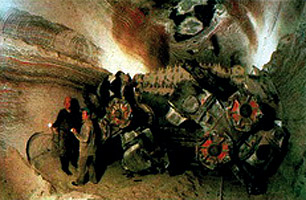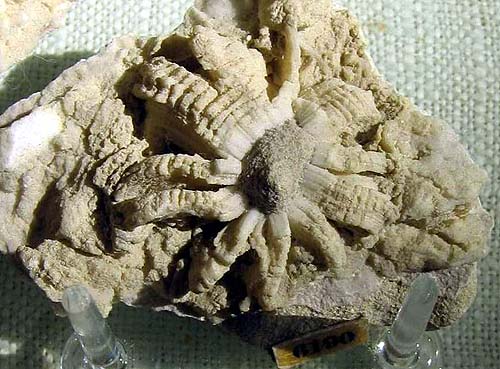Carbonates: Potassium nitrate
 Diagnostic card.
Diagnostic card.
K NO 3
Diamond orthogonality
Hardness 1.5-2
Specific weight 2.2
Cleavage is perfect
Color white and light gray
Glitter glass
It is also known under the names of nitrocalite, nitro and salnitro. It is represented by thin crusts, efflorescences, bundles and aggregates of needle crystals. It can be massive, granular and earthy. Gloss is glass, transparent, white or light gray.
Diagnostic signs.
Externally very similar to sodium nitrate, but crystallizes in the bipyramidal class of rhombic syngony as aragonite. Sodium nitrate, on the other hand, is isostructural with calcite. Potassium nitrate is less acid soluble than sodium nitrate, not hygroscopic.
Potassium nitrate has the ability to explode from detonation in a mixture with other explosives (which poses a certain danger and is not recommended for home collecting). Potassium salts are used as mineral fertilizers in agriculture (rare and expensive).

Bereznikovskoe potash deposit (in the mine).
Origin.
It occurs widely, but in small amounts in the form of surface raids and efflorescence in arid regions. It is formed by the action of bacteria on nitrogenous organic substances. Organogenic origin.
Place of Birth.
It occurs together with calcareous nitrate in Chile. In the form of efflorescences on various rocks is present in Spain, Egypt, Arabia, India, Iran. Removed from the caves in Tennessee, Kentucky, Alabama, Ohio. Used to make gunpowder during the War of Independence in North America.
Potassium salts are concentrated in the Verkhnekamsk saline basin of Russia (Solikamsky and Bereznikovskiy combines in the Perm region of the Russian Federation), their considerable reserves have been explored in Belarus (the Pripyat potassium basin), Ukraine (the Carpathian basin), Turkmenistan (Central Asia). A salt-bearing basin is found in Eastern Siberia of the Russian Federation (Irkutsk region). From sea water, compounds and salts of iodine, bromine, magnesium, potassium, etc. are also extracted.

Potassium nitrate. Rocky with. (Formerly Tatar Bodrak), Crimea, Ukraine. Photo: © А.А. Evseev.
Large doses of potassium cause paralysis of the heart. Excess intake of K + ions causes overloading of the corresponding homeostasis systems and disturbance of metabolic processes. In the epithelium of the gastrointestinal tract and renal tubules inflammation develops, often leading to tissue necrosis. Excess potassium and sodium causes an increase in the level of insulin in the blood. There are other hormonal disorders. The accumulation of potassium in the blood, hyperkalemia (at concentrations above 0.06%) leads to poisoning accompanied by paralysis of skeletal muscles; At a concentration of potassium in the blood, exceeding 0.1%, death occurs. The use of potassium drugs can cause a weakening of the contractile activity of the heart muscle, so in such cases, sodium preparations are prescribed instead of potassium. The development of hyperkalemia is promoted by acidosis.
The main manifestations of excess potassium: increased excitability, irritability, anxiety, sweating; Weakness and paresis of the muscles, degenerative neuromuscular disorders; cardiopsychoneurosis; Arrhythmias, weakening of the contractility of the heart muscle; Paralysis of skeletal muscles; Intestinal colic; Frequent urination; Predisposition to the development of diabetes. People with excess potassium are easily excitable, vulnerable, hyperactive, suffer from excessive sweating, accelerated urination.
Potassium is necessary: with a deficiency of the heart muscle, heart rhythm disturbances, fluid retention in the body, hypertension. Some diuretics, phenolphthalein increase the excretion of potassium by the kidneys. Sodium, cesium, rubidium, thallium have antagonistic properties with respect to potassium and can displace it from tissues. With a deficiency of sodium and potassium, the content of lithium in the body increases. The main functions of potassium in the body: maintaining the consistency of the cell and intercellular fluid, acid-base balance, providing intercellular contacts, bioelectrical activity of cells, maintaining neuromuscular excitability and conduction, participation in neural regulation of cardiac contractions, maintenance of water-salt balance, osmotic pressure , The role of the catalyst in the metabolism of carbohydrates and proteins; Maintenance of a normal level of a blood pressure, participation in maintenance of function of kidneys.
Potassium and sodium chlorides, being strong electrolytes, take part in the generation and conduct of electrical impulses in the nervous and muscular tissues. Thus, potassium is involved in maintaining the electrical activity of the brain, the functioning of the nervous tissue, the reduction of skeletal and cardiac muscles. Potassium regulates the activity of such important enzymes as K + -ATP-ase, acetylkinase, pyruvate phosphokinase. The therapeutic value of potassium is associated with its irritating effect on the mucous membranes, with an increase in the tone of smooth muscles (intestines, uterus), because of which its compounds are used as a laxative. Potassium causes the expansion of the vessels of internal organs and the narrowing of peripheral vessels, which contributes to increased urination. It slows down the rhythm of the heartbeats and, acting in a manner similar to the vagus nerve, participates in regulating the activity of the heart.
Bromine . In the adult body contains about 260 mg of bromine. Bromine is found in the blood (up to 10 mg / l), bone and muscle tissue; The highest concentration of bromine is found in the kidneys, pituitary gland, thyroid gland. The release of bromine occurs mainly with urine and sweat. Drugs created on the basis of bromine, reduce libido and potency, which is used to suppress sexual desire.
Bromides participate in the regulation of the central nervous system, strengthening in it the processes of inhibition (sedatik). Bromine ions inhibit the activity of the thyroid gland, being antagonists of iodides, and with a chronic effect they slow down their assimilation. Deficiency of bromide anion led to a deterioration in the growth of goats, fertility, a decrease in hematocrit, a decrease in the amount of hemoglobin in the blood, an increase in the fat content of milk and the number of miscarriages, and a shorter life expectancy. Insomnia was observed in dialysis patients with bromide deficiency. Bromine is necessary: with hysteria and neurasthenia as a sedative, hypnotic and anticonvulsant.
Excessive accumulation of bromine in the body leads to skin diseases and CNS depression. The main manifestations of excess bromine: skin rash, pustules, mild inflammatory nodes of violet-red color, rhinitis, bronchitis; indigestion; Sleep and speech disorders, memory loss, other neurological disorders. Sodium bromide (NaBr) is involved in the activation of pepsin, activates some enzymes, in particular lipases and amylases of the pancreas, involved in the digestion of fats and carbohydrates. Bromine ions inhibit the activity of the thyroid gland, being antagonists of iodides, and with a chronic effect they slow down their assimilation.
Poisonous and radioactive dangerous stones and minerals
** - poisonous stones and minerals (mandatory check in the chemical laboratory + explicit indication of toxicity)
** - radioactive stones and minerals (mandatory check on the standard dosimeter + ban on open sales in case of radioactivity exceeding 24 milli / g / h + additional measures of population protection)
Catalog of minerals and semi-precious stones of the world by groups
** - poisonous stones and minerals
** - radioactive stones and minerals


Comments
When commenting on, remember that the content and tone of your message can hurt the feelings of real people, show respect and tolerance to your interlocutors even if you do not share their opinion, your behavior in the conditions of freedom of expression and anonymity provided by the Internet, changes Not only virtual, but also the real world. All comments are hidden from the index, spam is controlled.